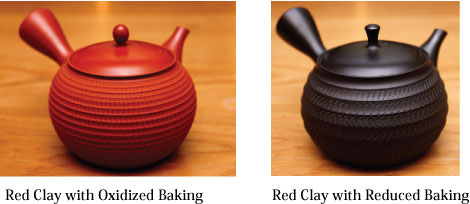-
Purple Clay Teapot in Japan
Terminology of Clay
For Yixing teapot, it is produced of Zisha. I would like to clarify the terminology of Zisha 紫砂(Purple Sand) once again. Zisha refers to crude clay rock that is produced in Yixing. Any clay that is produced outside of Yixing, other part of China included is not called Zisha even if its character is similar or identical.
Zisha is the mixture of 3 clays, red clay, purple clay and green clay in general. Different clay has different effect. Each type of clay has a different mineral composition and therefore makes the taste of tea obviously different. Various interactions or sort of ion-exchange reactions occur between the minerals that exist in water and the minerals in the clay.
Minerals could take different colors depending on the baking temperature and oxygen level
When iron is baked with oxygen, it oxidizes to become Fe3+ (Magnetite). On the other hand, iron becomes Fe2+ (Hematite) when it is baked with less oxygen or without it entirely. With less oxygen, fire generates carbon monoxide. This carbon monoxide will draw oxygen away from the iron.
The following picture shows 2 teapots that are produced from the same clay.

On the other hand, there are a number of teapot that is made of originally black clay. Those black teapots are mainly dominated by Manganese. The Manganese appears in black when it is baked with oxigen. Usually mannagese does not make taste better. Hence it is important to select teapot not only just based on the color, but also with proper understanding of clay.
What is the difference in effect using between artificially mixed clay and natural clay?
The natural clay and mixed clay gives a different effect, although they looks visually similar. The iron particle exists in natural red clay is in crystallized iron granule, just like gem stone. Artificially mixed red clay contains added iron which is ground by granulator. The shape of iron particle is very uneven and large surface area due to the hammering by granulator. Usually artificially added iron has very low melting point because of larger surface, which unable the clay to withstand high baking temperature up to >1200 degree C, while the melting point of iron particle in mixed clay is at around 600-800 degree C. Once iron particle get melted during baking, it liquidize and drastically loose the surface area.
Nowadays most of red clay teapots both in Japan and China are made from artificially mixed red clay. It is due to the reason that we start forgetting the effect of natural red clay and tends to choose teapot based on the outlook or the fame of the artist.
« Hojo : Tetsubin : Japanese Cast Iron Kettle&Niigata Tsuiki Do-ki Teapot which Made of 99.99% of Tin... à Nos Chères Terres...Généralités » Tags : purpleclay, hojo, terre, argile, japan, teapot, clay
Tags : purpleclay, hojo, terre, argile, japan, teapot, clay
-
Commentaires

